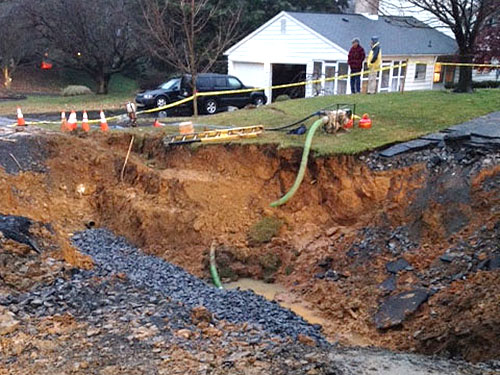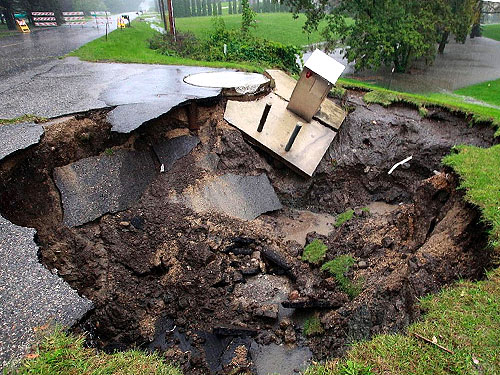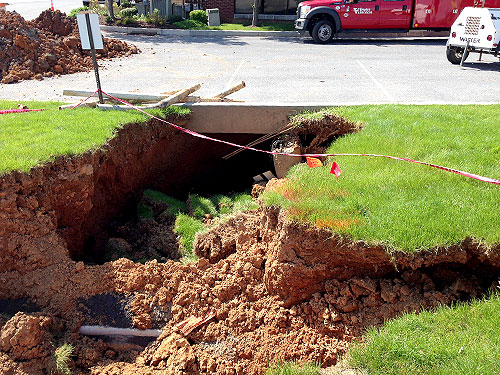SINKHOLES
What is a sinkhole?
According to the U.S. Geological Survey (USGS), a sinkhole is a depression in the ground that has no natural external surface drainage. In other words, when it rains, all of the water stays inside the sinkhole and typically drains into the subsurface. Some are shaped like bowls or saucers whereas others have vertical walls; some hold water and form natural ponds.

Where and how do sinkholes occur?
Sinkholes form in areas called “karst terrain,” which are regions where the rock below the land surface is limestone, carbonate rock, salt beds, or rocks that can naturally be dissolved by groundwater circulating through them. When water from rainfall moves down through the soil, these types of rock begin to dissolve and spaces and caverns develop underground.
Typically, sinkholes form so slowly that little change is noticeable, but they can occur suddenly and cause a collapse if there is not enough support for the land above the spaces. Such a collapse can have a dramatic effect, damaging streets, homes, property and water and sewer infrastructure.

Why do sinkholes happen here?
In some Pennsylvania counties, sinkholes are a definitive part of the landscape. The chemical and physical processes that helped form this unique landscape have taken place over thousands and thousands of years.
Sinkholes are common in Pennsylvania’s karst terrain underlain by carbonate bedrock (limestone and dolostone). These rocks are more easily dissolved than other rocks by a weak, naturally forming acid formed by the mixture of water and carbon dioxide. This dissolving process is enhanced along the many fractures found within the bedrock and over time has created a unique subsurface plumbing network.
According to the PA Department of Conservation and Natural Resources, “Just as we have drains and pipes in our homes that help move water from one place to another, the karst system uses the widened fractures as drains and pipes in the carbonate bedrock to help convey water to the water table.” Although the drains in the karst network are usually clogged with soil, water can de-clog and flush the drains open – creating a sinkhole.
Because of the water-driven nature of karst terrain, it tends to be more sensitive to changes in land use and development. Also, stormwater can infiltrate and affect the underground soil. This is particularly true with older streets that have cracks.

Do water main breaks cause sinkholes?
Generally, water lines do not just break. They are typically caused by one or a combination of factors, such as soil erosion, rapid change in water temperature, weather-related freeze/thaw cycles, stormwater run-off, and vibration from traffic. Many areas within our service territory are highly prone to sinkhole activity, because of the underlying geology and karst landscape. Oftentimes, our water infrastructure is damaged by the sinkholes in these areas, or sinkholes will occur where no water mains exist.

What can you do?
Homeowners are advised to research if past sinkhole activity has occurred in their community. The DCNR website’s interactive map can help. Also, make sure to correctly position the home’s downspouts and use water run-offs and splash blocks, so that no water is channeled directly to the home’s foundation. For houses with underground drainage to the street, homeowners should check to ensure that the underground pipes are not leaking and are working properly to channel water away from the home.
Finally, homeowners who live in sinkhole-prone areas might want to consider purchasing sinkhole insurance. Check with your insurance provider to find out what kinds of protection are available, including water run-off mitigation, insurance coverage options, terms, restrictions and costs.
Visit interactive map on DCNR website to locate sinkhole areas in Pennsylvania.
Links for more information:
